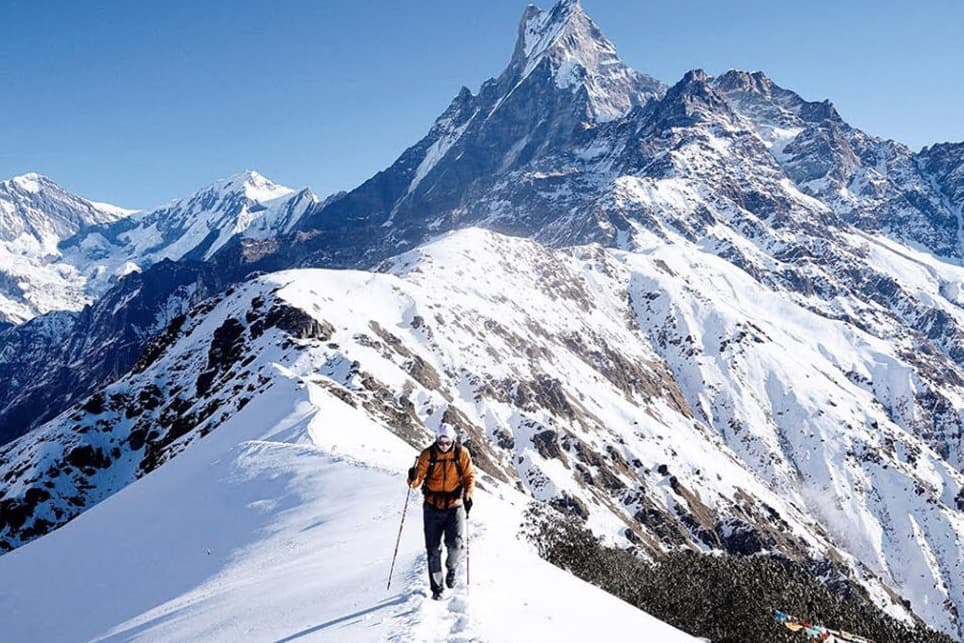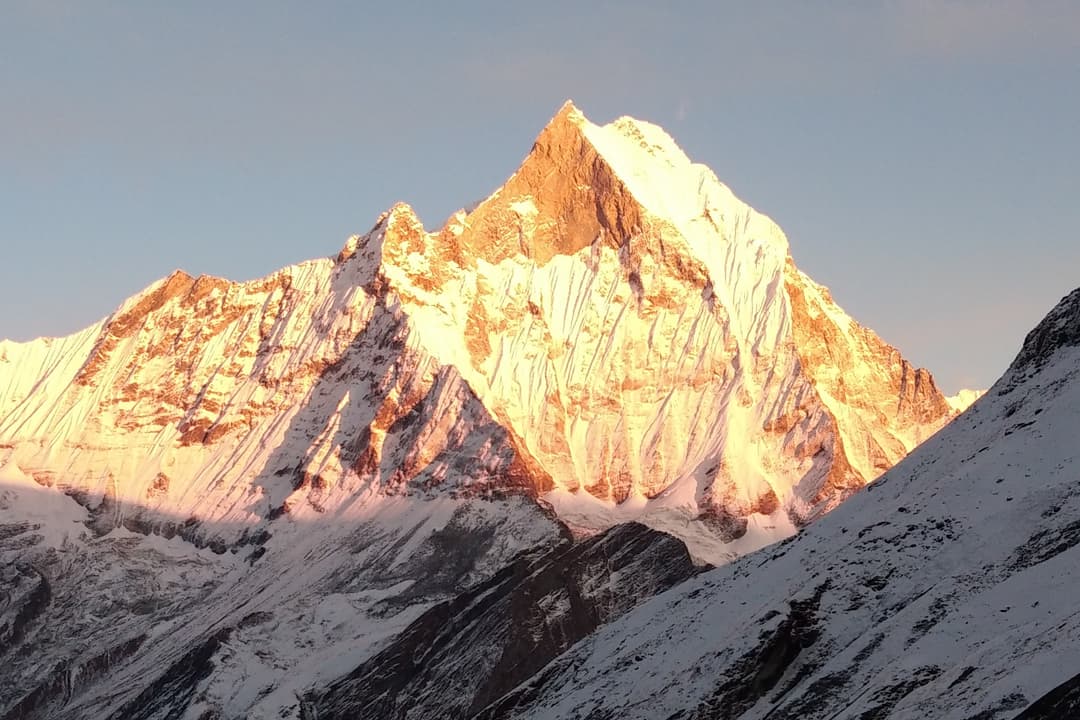Permits Required for Trek to Kapuchhe Lake
- Annapurna Conservation Area Permit (ACAP): This permit is mandatory for anyone trekking within the Annapurna Conservation Area, which Kapuche Lake falls under. It contributes to the conservation efforts in the region and helps sustain the local communities. It costs NPR 3,000 for foreigners and NPR 100 for SAARC nationals.
- Trekkers' Information Management System (TIMS) Card: This card helps the local authorities track trekkers in the region for their safety. It's also mandatory for all trekkers in Nepal, no matter where they are trekking. It costs NPR 1,000 for foreigners and NPR 500 for SAARC nationals.
Simple Packing List for Kapuchhe Lake Trek
Packing light is key to enjoying your trek to Kapuchhe Lake, so here's a simple list of essentials to keep in your backpack:
- Hiking shirt and pants
- Warm fleece or down jacket
- Rain jacket and pants
- Base layers
- T-shirts and shorts
- Hiking socks
- Warm hats and gloves
- Sunhats and sunglasses
- Strong Hiking Boots
- Sandals (for teahouses or lodges)
- Daypack
- Trekking poles
- Headlamp
- Water bottles
- Water purification tablets or filters
- First-aid kit
- Toiletries
- Quick-dry towel
- Camera and/or phone
- Sleeping bag
- Sleeping bag liner
- Trekking map and compass
- Cash and credit cards
- Travel Documents
- Permits
- Passport and visa
Best Seasons for Trekking to Kapuchhe Lake
The charm of Kapuche Lake changes with each season, offering unique experiences for your trek to Kapuchhe Lake. Even though trekking to Kapuchhe Lake can be done year-round, the first season is considered to be the spring and autumn seasons.
Spring Season:
The spring season starts in March and lasts until May. The temperature during the day will be between 18°C and 25°C and 5°C and 10°C during the night. The spring rhododendron season is one of the best seasons for you to trek to Kapuchhe Lake, as it offers you fantastic views of enchanted rhododendron forests.
With minimal rainfall and a clear sky, the springtime presents magnificent panoramas of the Annapurna Himalayas, encompassing Annapurna II, Annapurna IV, Dhaulagiri, and Lamjung Himal. Beautiful scenery will be created on your routes by the snow-capped peaks reflected in Kapuche Lake's crystal-clear waters.
Even though the spring season is considered one of the most popular seasons to trek to Kapuchhe Lake, it is less crowded compared to the autumn season.
Autumn Season
The autumn season lasts from September to November and is considered one of the best seasons to trek to Kapuchhe Lake. The temperature ranges from 15°C to 22°C during the day, whereas it gradually decreases from 0°C to 5°C during the night.
On your trek to Kapuchhe Lake during the autumn season, you will be offered clear skies with minimal haze, presenting breathtaking panoramic views of the Annapurna Himalayas. You'll witness the majestic peaks like Annapurna II, Annapurna IV, Dhaulagiri, and Lamjung Himal in all their glory, their snow-capped summits reflected in the still waters of Kapuche Lake.
The autumn season will also offer you a festive spirit, as Nepal’s two major festivals, Dashain and Tihar, fall under this season. Trekking to Kapuchhe Lake in the autumn season will allow you to immerse yourself in the vibrant celebrations, witness traditional dances and music, and have a chance to experience the warm hospitality of the local people.
Here's a breakdown of the four seasons:
|
Season
|
Daytime Temperature
|
Nighttime Temperature
|
Overview
|
|
Spring (March-May)
|
18°C–25°C
|
5°C-10°C
|
Vibrant rhododendron forests are in bloom, painting the hillsides with splashes of red, pink, and purple. Pleasant trekking conditions with clear skies and moderate temperatures.
|
|
Summer (June-August)
|
22°C-30°C
|
10°C-15°C
|
Lush greenery takes over the landscape, but be prepared for frequent rains and occasional landslides. This season is less crowded, but good waterproof gear is essential.
|
|
Autumn (September-November)
|
15°C-22°C
|
0°C-5°C
|
The best panoramic views of the Annapurna Himalayas have clear skies and minimal haze. The lake is typically unfrozen, reflecting the stunning backdrop.
|
|
Winter (December-February)
|
5°C-15°C
|
5°C-10°C
|
A unique sight of Kapuche Lake frozen over, creating a mesmerizing winter landscape. Be prepared for colder temperatures and potentially snowy conditions.
|
Accommodations during Kapuchhe Lake Trekking
In terms of accommodation, there are various tea houses and lodges that we will offer you during your 4-day trek to Kapuchhe Lake.
The tea houses and lodges are the most basic accommodations available along the routes of the Kapuche Trek. These tea houses and lodges offer comfortable rooms with basic facilities like WIFI, hot showers, and charging stations. However, in some teahouses or lodges, additional charges might be added.
Food during Kapuchhe Lake Trek
Throughout your trek, you will be offered simple and basic Nepali foods like rice and lentils (daal bhat), vegetables, and fruits.
A warm, soothing bowl of porridge with fresh fruit, eggs, and toast is what you can expect for breakfast. The scent of freshly brewed local tea and the warmth of the morning sun will provide the ideal atmosphere to start your adventure.
For lunch, your lunch will usually consist of a combination of foreign and traditional Nepali cuisine. A vital component of Nepali serving, Dal Bhat is a filling dish made with rice, lentil soup, and a variety of side dishes. It's an experience rather than just a meal. There are also familiar alternatives like noodles and sandwiches for people who are craving something from home.
Similarly, the teahouses are a great place to relax and have a nice drink or two in the evening. You can enjoy the richness of a hot chocolate or a cup of traditional butter tea while you share stories with other trekkers. There are also a variety of snacks on the menu, such as roasted nuts and local delicacies. Your dinner will be the same as lunch, followed by dal bhat and vegetables.
Difficulty Level during Kapuchhe Lake Trek
The trek to Kapuchhe Lake is a moderately difficult one. To make it easier for you without having to compromise on adventure and thrill, we have designed this 4-day trek to Kapuchhe Lake package for you.
Our tek is appropriate for people of all ages and frequently involves trekking below an elevation of 3,000 meters. Those who have never trekked before but are interested in spending a few days trekking in the mountains can also do this trek.
Trekking can take about 4 days, and it involves walking uphill and downhill for about four to five hours each day. Anyone with a basic level of fitness can easily finish this phase of the trek. There is less chance of altitude sickness because the daily altitude rises vary from 300 to 600 meters.
Safety Guidelines
Ensuring safety during Kapuche Lake Trekking is a key element to having a comfortable and fun journey. Our guides will be there to ensure your safety during the trek. Here are some of the safety guidelines that you should consider from your side:
- Stay hydrated by carrying a sufficient amount of water and purifying tablets or a water filter. Consume a balanced diet to maintain energy levels during the trek.
- Make sure you have comprehensive travel insurance that covers trekking activities, medical emergencies, and evacuation if needed.
- Invest in good-quality trekking gear and make sure to dress in layers in case of sudden weather changes.
- Pay attention to your body and inform our guides if you feel any sign of discomfort.
- Follow designated trails, and make sure that you are not walking too close to the edges.
Kapuchhe Lake Trek Travel Insurance
The Kapuchhe Trek is classified as moderate, meaning that the risk of altitude sickness is quite low. On the other hand, unanticipated occurrences like landslides, floods, accidents, or sudden changes in the weather might occur throughout the trek.
Therefore, travel insurance is required for the Kapuche Lake Trek. Insurance coverage is required for medical and emergency extradition, as well as for the costs of high-altitude helicopter rescue and evacuation.
Following the booking of your trek to Kapuchhe Lake, we kindly request that you send us a complete set of insurance documents. We'll use your insurance to immediately save you in case of an emergency.




